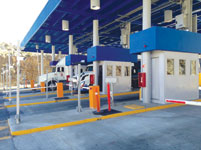
Enforcement and security organisations are responsible for detecting suspicious vehicles which may be stolen, have a record of criminal offences, or driven by those seeking to evade highway speed cameras, or be on an alert list of security forces.
Vehicles have many parameters which can identify them and enforcement agencies need to build a full and complete picture, with licence plates being one of the major parameters. A city or country-wide database of licence plates and vehicle owners would enable enforcement agencies to share data, and respond to alerts in real time, thus serving their communities more effectively. Until now, basic licence plate recognition (LPR) systems have been limited and unable to provide a full and complete picture including car make, or jurisdiction.
Detect, classify, identify
HTS’s new Vehicle Identity Recognition (VIR) suite is a Licence Plate Recognition (LPR). This patented technology incorporates video analytics, advanced image processing and computer vision capabilities. Working together with the company’s LPR systems, the VIR suite recognises vehicle manufacturer logos (car models) and plate colours, special plate icons and country or state names. It makes comparisons between vehicle parameters, providing a more complete picture with great accuracy.

In gated communities, airport entrances, toll booths, border crossings, parking garages, and corporate campuses, licence plate recognition systems outfitted with the new vehicle recognition feature can be installed at access lanes. There, they automatically monitor vehicles entering and exiting the area, detecting any discrepancies between the vehicle type and its licence plate number, as is registered in relevant databases.
Border crossings are another hot spot where HTS technology is increasingly deployed around the world. Border patrols are primarily concerned about smuggling of drugs, weapons and even people. The company's software counts and monitors every vehicle coming in and out.
Collecting tolls and parking garage fees are less glamorous tasks, but the OCR products are in demand for streamlining these processes across the globe. As each car enters a parking lot, the licence plate is read to automatically enter pre-paid users and calculate the charge for others by comparing the exit and entry times. An optional face-imaging tool can prevent car hijackings and add an extra layer of security. The system cuts down so drastically on wait times, that an LPR equipped parking facility needs fewer entrances and exits and fewer personnel manning the stations. The same is true for toll plazas.
The suite’s recognition capabilities greatly enhance verification and classification. Making correlations between car types, licence plate numbers, and data stored on enforcement agencies, police and homeland security databases, the system can sound immediate alerts when suspicious vehicles pass through. In addition, the new HTS VIR suite provides an interface for communication with law enforcement agencies and increases the efficiency of perimeter security for industrial or critical infrastructure facilities, toll road operators, border guards and parking garage operators.
Character recognition experts
As a sedan approaches a busy airport or a secured facility, the HTS VRS vehicle identity recognition system instantly gives security personnel a summary of the car's make and model, the country or state that issued the licence plate and the holder of the plate.
Much more than simply tracking users at this sensitive security point, the VRS is also a first alert. What if the car is recognised as a Corolla but the plate is registered to a Ford Focus owner? Either the licence plate was switched or the car is stolen – a clear red flag.
VRS is the patented product of HTS, which has specialised in optical character recognition (OCR) solutions since 1992. Forty countries use HTS products to fight terrorism and crime, as well as manage cargo, traffic and toll roads – including all ships leaving the ports of the United States.
VRS licence plate recognition and container identification offer both automation and security solutions that can work in many different scenarios and add value to many different market sectors.
Today, HTS is behind security and efficiency systems working in Australia, South Africa, Spain, Portugal, the United Kingdom, Belgium, the Netherlands, Germany, North America, Mexico, Brazil, Argentina, Kenya, Ghana, Zambia, Hong Kong, Vietnam and a host of other areas.
For more information contact STSS, +27 (0)74 266 0074, info@st-ss.co.za
© Technews Publishing (Pty) Ltd. | All Rights Reserved.